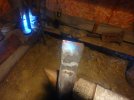Well...(if i may interject my $.02)..."Shallow quench",do you mean in Length of bit HT'd(like what i think Square_peg means above)?
That,i believe has to do with this being a remnant,a tail-end of a vital,living axe-culture.
Where the guy using that tool had an easy access to the smith;as the tool wore down it was more than just the L of the bit-it was the whole geometry of it.Then you just went back and had it drawn back out to shape,and re-HT'd while at it.So that there was no need to have too long of the bit HT'd.
As far as Quench/pause/dunk:The Quench is the first dunk(it happens Fast,a few seconds at most*).
After that the Pause allows the smith to watch the heat penetrate back to the now-quenched edge from the thicker parts back that still retain Lots of heat.
He's watching for the correct Oxidation color to reach the edge(or,since he didn't give it a quick scrub with anything(colors are visible best on shined-up metal),he may just be going by time which he keeps track of by habit,by rote).
Once the correct color reaches the edge,i.e. the edge was Reheated to an Nth temperature(which Is Tempering),smith then terminates the entire process by dunking the whole enchilada.
Such tempering cycle is called "blacksmith's",or "self-tempering",when using the residual heat from the quench.
* "Shallow" can be a confusing term to use in such matters:There's a metallurgical meaning of this term as it applies to different alloys,"shallow-",vs "through-hardening".
"Plain-carbon" alloys(with Carbon the only alloying element) are considered "shallow-hardening"
That means that after a certain Thickness(i believe the standard is held to be 1/2"),the quench will not form Martensite(or other desired state)inside the forging,it'll loose it's T before the cooling can take it's place,and will form a different structure.
To fix that,to through-harden thicker forgings alloying elements are used,most notably Chromium.Cr carbides somehow facilitate and speed-up the process making the alloy "through-hardening".
I hope that's not too obscure...And thanks a LOT for these videos!I got lucky with my reception over the weekend and watched a bunch of those,WAY cool!!!

....


